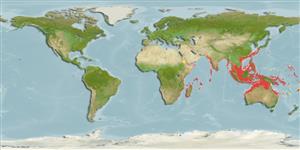Common names from other countries
Classification / Names / Names
Noms communs | Synonymes | Catalog of Fishes (gen., sp.) | ITIS | CoL | WoRMS
Environment: milieu / climate zone / depth range / distribution range
Écologie
; profondeur 0 - 250 m (Ref. 349). Tropical
Indo-West Pacific: from East Africa, including the Red Sea and the Persian Gulf, to eastern Indonesia; north to the Philippines and south to southern Indonesia.
Length at first maturity / Taille / Poids / Âge
Maturity: Lm ? range ? - ? cm Max length : 13.0 cm ShH mâle / non sexé; (Ref. 349); common length : 10.0 cm SHW mâle / non sexé; (Ref. 349)
Occasionally collected in shrimp trawls. Shell used in shellcraft (Ref. 349). Found on the bottoms of the continental shelf and upper slope. Also from shallow subtidal waters (Ref. 349). Members of the family Xenophoridae feed directly on sediments (Ref. 107881), collecting tiny detritus (Ref. 349) and foraminiferans (Ref. 104247).
Life cycle and mating behavior
Maturité | Reproduction | Frai | Œufs | Fécondité | Larves
Members of the order Neotaenioglossa are mostly gonochoric and broadcast spawners. Life cycle: Embryos develop into planktonic trocophore larvae and later into juvenile veligers before becoming fully grown adults.
Poutiers, J.M. 1998. (Ref. 349)
Statut dans la liste rouge de l'IUCN (Ref. 130435)
statut CITES (Ref. 108899)
Not Evaluated
Not Evaluated
Menace pour l'homme
Harmless
Utilisations par l'homme
| FishSource |
Outils
Plus d'informations
Taille/ÂgeCroissanceLongueur-poidsLongueur-longueurMorphologieLarvesAbondance
Sources Internet
Estimates based on models
Preferred temperature
(Ref.
115969): 23.1 - 28.6, mean 27.3 (based on 918 cells).
Vulnérabilité
Low vulnerability (10 of 100).
Catégorie de prix
Unknown.
